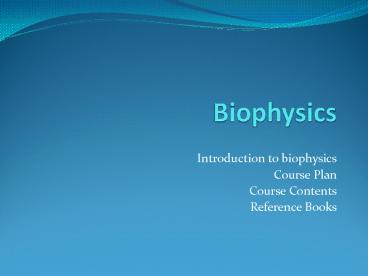Biophysics - PowerPoint PPT Presentation
1 / 14
Title:
Biophysics
Description:
Introduction to biophysics Course Plan Course Contents Reference Books What is Biophysics Biophysics is a specialized sub area of biology It is the science of ... – PowerPoint PPT presentation
Number of Views:2604
Avg rating:3.0/5.0
Title: Biophysics
1
Biophysics
- Introduction to biophysics
- Course Plan
- Course Contents
- Reference Books
2
What is Biophysics
- Biophysics is a specialized sub area of biology
- It is the science of physical principles of life
itself and of biological systems. Biophysics is
an interdisciplinary science that explains the
laws and principles of physics which govern
various biological processes. Biophysics spans
all levels of biological organization from
molecular scale to whole organism
3
Course Plan
- Quiz/Assignments 10 marks
- Sessionals 202040 marks
- Terminal 50 marks
4
Course Contents
- Introduction to biophysics
- Basic concepts
- Osmosis, osmotic pressure, surface tension,
diffusion, viscosity, thermal conduction, forces
and energy - Molecular structure of biological systems at a
glance - Energetics and Dynamics of Biological Systems
- Description of ATP, cell as an accumulator of
electrochemical energy, energy consumption,
respiration, mechanism of molecular energy
transfer, thermodynamics and thermal molecular
movement, mechanism of body temperature
regulation, photosynthesis as a process of energy
transfer and transformation, dynamics of blood
flow, control of movement
5
Course Contents
- Biological Membranes
- Membrane chemistry and structure, membrane
physics, surface and interfacial tensions,
diffusion and mobility of ions, electrostatic and
mechanical properties of membranes - Mechanical Properties of Biological Materials
- fluid flow, blood circulation, muscle
contraction, swimming, flying etc - Electric fields in cells and organisms
- Nerve Signals, nerve impulses, nervous system
- Physical factors of the environment
- Temperature, pressure, mechanical oscillations
(vibrations, sound, hearing and hearing aids,
effect of ultrasound), electromagnetic fields in
the environment, ionizing radiations
6
ebooks
- Textbook
- Biophysics by P. S. Mishra, 2010
- Reference books
- Molecular And Cellular Biophysics by Meyer B.
Jackson, Cambridge University Press, 2006 - Biophysics by Roland Glaser, Springer, 2001
- An Introduction to Med. Biophysics by Parveen
Parkash
7
- Biological activities happening in different
organs of living body like kidney, liver, heart,
lungs as well as those in intracellular and
extracellular biological fluid are governed by
fundamental laws of physics namely - Diffusion
- Osmosis
- Viscosity
- Surface Tension
8
Osmosis
- The spontaneous passage of solvent from a
solution of lower concentration towards a
solution of higher concentration when the two
are separated by a semi permeable membrane is
called osmosis - Osmosis is a special case of diffusion. It
involves the diffusion of water through the semi
permeable membrane to equalise the concentration
of solutions on its two sides
9
Osmosis in fresh and sea water fish
Fresh water trout
Sea water Herring
10
Turgid plant
wilting
The cells have taken up water by osmosis the
cells are turgid and the tissue is firm
These cells are short of water the tissue is
limp and the plant is wilting
11
Growth in a shoot tip
25
cell division continues
these cells will divide
vacuoles forming
cells absorb water by osmosis and expand
12
Effect of different solutions on blood cells
13
Osmosis
- Osmosis releases energy, and can be made to do
work, as when a growing tree root splits a stone.
- Diffusion and Osmosis are both types of PASSIVE
TRANSPORT - that is, no energy is required for
the molecules to move into or out of the cell. - Osmosis takes place due to difference in chemical
potentials of water on two sides of membranes
which leads to pressure gradient - Solute decreases chemical potential of water.
Water tends to flow from where its chemical
potential is higher to where it is lower - Reduced chemical potential causes reduced vapor
pressure, lower freezing point and higher
boiling point of the solution as compared with
pure water
14
Osmotic Pressure
- Osmosis may be opposed by increasing the pressure
in the region of high solute concentration
(hypertonic solution) with respect to that in the
low solute concentration region (hypotonic
solution). - The hydrostatic pressure which just stops osmosis
is the osmotic pressure - The force per unit area, or pressure, required to
prevent the passage of water through a
selectively-permeable membrane and into a
solution of greater concentration is equivalent
to the osmotic pressure of the solution, or
turgor. - Osmotic pressure is a colligative property,
meaning that the property depends on the
concentration of the solute but not on its
identity.

